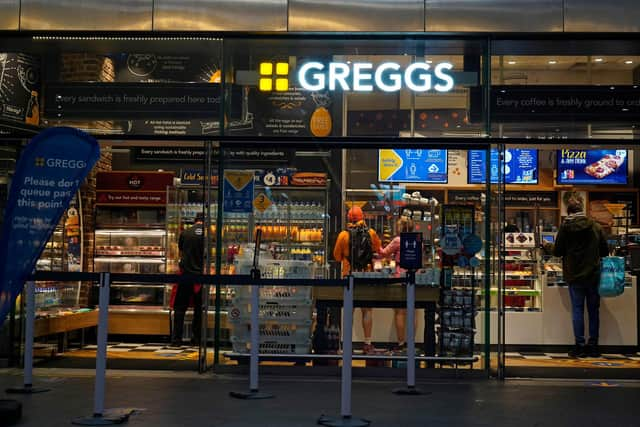Greggs vs Pret debate replaces Watford Gap as new North-South dividing line: Jayne Dowle
According to physicist Dr Robin Smith from Sheffield Hallam University, who has conducted a new study by adapting machine learning techniques normally used to look at nuclear reactions, the true North/South division rests on a complex algorithm involving Greggs sausage rolls and Pret a Manger sushi rolls.
Dr Smith and his machine have calculated and compared the locations of both food retailers, factoring in the presence of supermarkets Waitrose and Morrisions as a check. Their findings, he argues, prove that where we buy our sandwiches is an unbeatable indication of whether we’re in the North or the South.
Advertisement
Hide AdAdvertisement
Hide AdGreggs has its roots in the north of England, opening its first shop in Tyneside in 1951, with Pret, which first opened in Hampstead in north London in 1984, typically concentrated in the south-east. There are now believed to be 1,777 Greggs branches in England – off the top of my head at least seven of these in my home town of Barnsley – and 424 Pret a Manager outlets.


The analysis was adjusted to take into account the larger number of Greggs in total, but on the basis of numbers alone, it should prove to the government once and for all that the ‘North’ is a certainly powerful force. And an army marches on its stomach, after all.
Dr Smith and his machine produced a North/South line that includes the top of Norfolk and all of Cornwall and Bristol, decreeing these regions we might think of as southern to be spiritually and culinarily northern, quite a surprise to locals you would imagine.
In addition, on the basis of these new findings, Birmingham, Coventry and Leicester, which often fall into a disputed grey area, should be firmly considered ‘northern’. All power to our elbow, I say.
Advertisement
Hide AdAdvertisement
Hide AdDr Smith’s research pinpoints on the finding that there is a preponderance of Greggs in this new north and more ‘Prets’ in the south. Although Cornwall, which is famous for its own, eponymous, pasties, in an anomaly. At the last count, there were only two Greggs and no Prets in the county.
Sophie Maclean, from King’s College London, is working on a Phd in number theory, says that maths has finally ended the discussion that historians have been arguing over for more than a millennium.
Speaking at the Cheltenham Festival of Science, and citing Dr Smith’s research, she pointed out that is often said that it was William the Conqueror who noticed that the residents in the north of his kingdom were more unruly, and “In mad fury . . . descended on the English of the north like a raging lion.” There’s a counter-argument to this that as a Norman, the 1066 invader was actually descended from ‘Northmen’ who came to France from their frozen far northern eyries in what is now Scandinavia, in search of the good life (and land). But perhaps we will leave that one for another day.
“There’s a lot of debate but thankfully mathematicians have worked this out,” said Maclean. “Really there is only one way to judge what’s north and what’s south and that is by looking at the distribution of Pret and Greggs.”
Advertisement
Hide AdAdvertisement
Hide AdYou might wonder whether arguing over a steak bake is a good use of academic time, but this is serious stuff.
Whilst there are healthy, and not-so healthy options available at both food retailers, it is very fair to say that Greggs has certainly stolen a march in areas dominated by lower-income households. In such communities, it’s statistically more probable that lower-income equals endemic health problems, benefit dependency, poorer educational attainment and less social mobility.
‘Greggs’ has become a shorthand term, often derogatory, for defining an area as not quite up to scratch. It’s part political and social kneejerk, part the food snobbery that constantly hobbles meaningful discussion about serious topics such as the cost of living, children’s eating habits and obesity.
And as such, Greggs has been abused, frankly, by politicians trying to prove their ‘man of the people’ credentials. I forget the arcane details of former Chancellor George Osborne’s punishing ‘pasty tax’ a decade or so ago.
Advertisement
Hide AdAdvertisement
Hide AdBut I do recall that when an unedifying row blew up over whether he had ever partaken of a Greggs pasty, Labour’s Ed Miliband, Rachel Reeves, and Ed Balls made a big show of rocking up to a Greggs branch to be photographed buying sausage rolls.
This could be payback time. Stand by your Pret strawberry and granola yoghurt pots Westminster. A Northern invasion, led by the foot-soldiers of Greggs in hairnets and overalls, may be under way, warns Dr Smith: “Since Greggs produced the vegan sausage roll … it has become more popular in the south, so this might not be a marker of northernness for that much longer.”